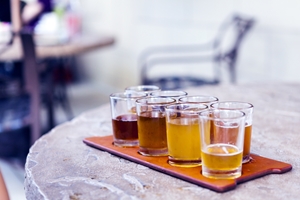
A different kind of beer
As Draft magazine explained, culinary brewers tend to work primarily with stouts and porters, rather than lighter beers like lagers. These heavier drinks are especially well-suited for adding elements beyond the traditional hops, grain, yeast and water. Their full bodies and strong flavors serve well for drinkers interested in complex layers of aromatics and unusual ingredients.
“Culinary brewers primarily work with stouts and porters.”
Dogfish Head Craft Brewery, based in Milton, Del., was ahead of the game in trying out the adventurous tastes that characterize culinary brewing. Beginning with a Rehoboth Beach brewpub location in 1995, the company made its name with beers like the Punkin Ale, a brown ale flavored with pumpkin, brown sugar and spices. That recipe is still available on a seasonal basis, along with an array of other unconventional brews.
According to Dogfish Head’s founder Sam Calagione, the culture around mixing gourmet-inspired flavors into ales has shifted significantly since the company’s early days. He discussed the changing world of craft beer with Tasting Table.
“For the first five years, we were mostly looked upon as heretics and weirdos for doing these beers,” he said. “Now, it is great to see hundreds of craft breweries, if not thousands, coloring outside of stylistic guidelines.”
The Brewers Association agreed that the way people drink beer has changed a great deal in recent years. According to a 2015 survey conducted by the organization, 47 percent of people who drink craft beer said they frequently do so while eating, with 45 percent stating they had beer with food more often than two years earlier. This expanded interest in making beer part of the dining experience has created a wider base of consumers for culinary brewing.
Drinking innovation
Culinary brewers have employed a variety of fascinating new tastes and embarked on fruitful collaborations. Jared Rouben of Moody Tongue Brewing in Chicago has emerged as a leading figure in the city’s burgeoning culinary beer scene. Rouben, who trained as a chef, draws on his background to develop unique and delicious beers, emphasizing the importance of using high-quality ingredients to highlight flavors and aromatics. He explained to Crain’s Chicago Business why he thinks this style of brewing has grown so popular.
“People are becoming more passionate about what they consume.” Rouben said. “This approach allows the brewer to build a bridge from what is traditionally done in the kitchen to our guests’ glass, providing the drinker with the absolute highest-quality experience.”
The brewery built its reputation on fascinating tastes, such as the lemon meringue pie flavor found in the Steeped Emperor’s Lemon Saison. The brewery suggests pairing this acidic and aromatic beer with grilled octopus or panna cotta. The Caramelized Chocolate Churro Baltic Porter takes on the flavors of vanilla, chocolate and cinnamon, suitable for sipping alongside blue cheese or a bread pudding.
 Many establishments that serve culinary beers also suggest pairings.
Many establishments that serve culinary beers also suggest pairings.While Moody Tongue only has a tasting room on its premises, culinary brewing has taken up residence in several area restaurants, offering the perfect complementary brews for diners. For instance, The Duck Inn has a beer pairing tasting so patrons can explore the range of possibilities, as well as a special selection of “food” beers.
Band of Bohemia, meanwhile, brews its own culinary beverages and provides customers with suggestions for which concoction should accompany various small plates. The orange chicory rye ale, for example, goes well with bison or the scallops prepared with mushroom, egg and peanuts in an aromatic broth. On the other hand, the roasted beet thyme ale pairs with the agnolotti, grilled lamb neck or foie gras.
As vibrant as Chicago’s offerings have become, innovative culinary brewing is hardly restricted to the city. Short’s Brewing Company operates its beer production and pub out of Bellaire, Mich., and offers a wide range of gourmet beers. The Soft Parade is a fruit-infused rye ale made with pureed strawberries, blueberries, raspberries and blackberries. Cookie Beer, a brown oat wine, features flaked oats, raisins, vanilla and brown sugar, as well as syrup and raisin aromatics.
At this and many other breweries, the principles that are taught in culinary academy have transformed the way people consume beer and enjoy it with meals. Chefs will increasingly benefit from a strong awareness of beer varieties and pairings. They should also be open to working closely with brewers and cicerones to develop the perfect combination of drink and food for each guest.




